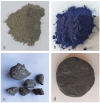Synthetic Aggregates and Bituminous Materials Based on Industrial Waste
- PMID: 39685441
- PMCID: PMC11643777
- DOI: 10.3390/ma17236002
Synthetic Aggregates and Bituminous Materials Based on Industrial Waste
Abstract
The transition to a circular economy requires new materials and products with new production designs, technologies, and processes. In order to create new materials with physico-chemical qualities suitable for application in the building materials engineering sector, stone dust and polymer waste-two environmentally hazardous industrial wastes-were combined in this study. The materials obtained were evaluated based on an analysis performed using the Micro-Deval test. The results obtained showed a Micro-Deval coefficient value of 7.7%, indicating that these artificial aggregates can replace the natural aggregates used in road construction. Additionally, it was shown that the stone dust used could be applied as a sorbent for dyes without later leaching this dye from the final synthetic stones. Another category of materials that meets the principles of the circular economy and was developed in this study is bituminous mastic, which is currently used for the hot sealing of joints in road infrastructure. For this purpose, a composite material was developed using stone dust and cooking oil to replace the filler, a non-regenerable source used for obtaining bituminous mixtures. Specific standard methods were used to assess the degree to which the new materials approach the behavior of commercially available products.
Keywords: bituminous mastic; circular economy; industrial waste; stone dust.
Conflict of interest statement
Iolanda-Veronica Ganea is an employee of MDPI; however, she did not work for the journal Materials at the time of submission and publication.
Figures





References
-
- Chandra S., Kumar P., Feyssa B.A. Use of Marble Dust in Road Construction. Road Mater. Pavement Des. 2022;3:317–333. doi: 10.1080/14680629.2002.9689928. - DOI
-
- Yang Q., Li Y., Zou H., Feng L., Ru N., Gan L., Zhang J., Liu J., Wang C. Study of the Effect of Grouting Material Strength on Semiflexible Pavement Material. Adv. Mater. Sci. Eng. 2022;2022:5958896. doi: 10.1155/2022/5958896. - DOI
-
- Tamrakar A., Saxena G., Saxena T. The consequences of waste marble dust on the mechanical properties of the concrete. Int. Res. J. Eng. Technol. 2018;5:285–288.
-
- Al-Hdabi A. Laboratory investigation on the properties of asphalt concrete mixture with Rice Husk Ash as filler. Constr. Build. Mater. 2016;126:544–551. doi: 10.1016/j.conbuildmat.2016.09.070. - DOI
-
- EC, 2021, ‘Zero Pollution Action Plan’. [(accessed on 25 July 2024)]. Available online: https://environment.ec.europa.eu/strategy/zero-pollution-action-plan_en.
LinkOut - more resources
Full Text Sources

